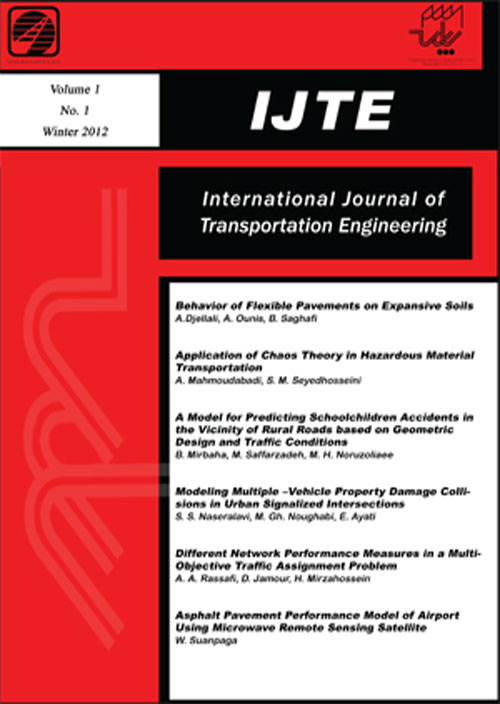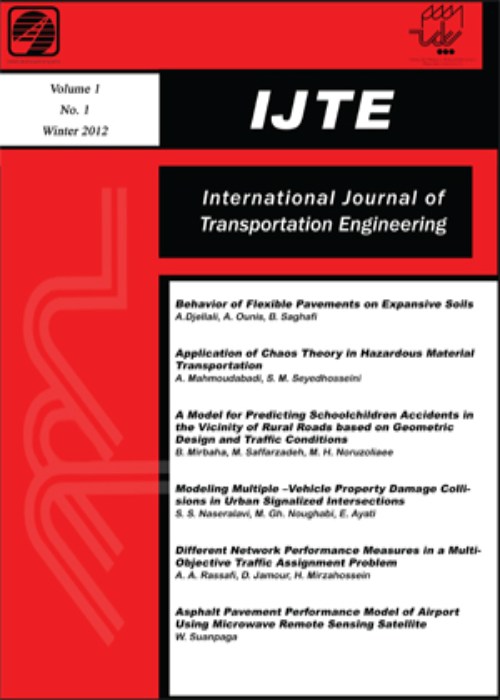فهرست مطالب

International Journal of Transportation Engineering
Volume:9 Issue: 1, Summer 2021
- تاریخ انتشار: 1400/06/31
- تعداد عناوین: 6
-
-
Pages 415-438
Today, one of the important frameworks in understanding and recognizing digital transformation in all activities is the digital transformation maturity model. Understanding the dimensions and stages of maturity is important for transportation decision makers because in this way they can make appropriate management decisions by understanding the position of their organization in the maturity of digital transformation. The main purpose of this study is to present the maturity model of digital transformation capability, determine its stages, and investigate the use of Intelligent Transportation Systems and the maturity of transportation-related activities. In this paper, meta-synthesis is used to study the different models and stages of digital transformation maturity in various scientific databases on the Internet and provide a comprehensive summary of the dimensions and stages of maturity. After evaluation, 30 transportation companies in Tehran and their main activities were selected. By analysing the dimensions and stages of maturity in previous papers, the maturity model presented in this paper includes five stages and 10 dimensions in transportation area. These dimensions include digital management, information technology, manpower, operations and processes, culture, organizational structure, innovation and change, new strategies, intelligent products and services and customer orientation. Therefore, the maturity of 14 transportation activities was measured. The results showed that most transportation activities are at level three of the maturity model. Also, dimensions that scored the most are, respectively, digital process and operations of transportation, digital innovation in transportation, structure and governance, and digital management in transportation.
Keywords: digital transformation, Transportation, Meta-Synthesis, Maturity model, Intelligent Transportation Systems -
Pages 439-458Traffic accidents and their consequences are among the major issues that need to be seriously addressed in today’s world. In this study, the prioritization of hazardous points on the roads is discussed, using multi-criteria decision-making (MCDM) techniques considering different natural and environmental criteria affecting road accidents. The Neyshabour-Sabzevar and vice versa road axes in Khorasan province, Iran, are considered as a case study for the implementation of the proposed method. Initially, 20 criteria were identified in 4 different categories to prioritize the hazardous points using the literature review and the experts’ opinion. In this paper, the MDL (Modified Digital Logic) and AHP (Analytical Hierarchy Process) methods are used to determine the criteria’s weights. By combining these techniques, four hybrid methods MDL-TOPSIS (Technique for order preference by similarity to an ideal solution), MDL-VIKOR (Vlse Kriterijumska Optimizacija I Kompromisno Resenje), AHP-TOPSIS, and AHP-VIKOR are obtained to prioritize the mentioned points, each producing different results. Two models were used to obtain the final ranking. In the first model, the results of these four methods are integrated using the COPELAND method. In the second model, the entropy method (Emerging Network To Reduce Orwellian Potency Yield) is used to modify the weight of the criteria. The innovation of the paper is presenting a new hybrid MCDM method that is used to prioritize hazardous points. Results showed that using the entropy method for modifying the weight of the criteria causes the methods to produce the same results. Moreover, results show that the number of deadly injured casualty of an accident is the most important criterion. Additionally, Zafaranieh residential area gained the highest priority.Keywords: Hazardous Points, MCDM, ENTROPY Method, Copeland method, Hybrid ranking method
-
Pages 459-474Each natural and human element plays an essential role in the formation the morphological structure of cities, through which transportation systems are the most important factor among human factors. An integrated transportation strategy is a sustainable transportation strategy aiming to reduce inconsistencies and divisions in the transportation service management system. As the largest metropolis in the country and the Middle East, Tehran is facing serious problems with its transportation system. However, sufficient studies have not been conducted to comprehensively identify structural barriers in the urban management system of the Tehran metropolis to implement an integrated transportation management system. The paper aims to identify structural barriers in the urban management system of Tehran and provide an overview of measures that can be taken to implement this approach in this metropolis. The used research method is the survey-analytical method and a questionnaire was employed to collect data. The identified factors have been classified through confirmatory factor analysis (CFA) and analytic hierarchy process (AHP) methods and research hypotheses have been tested by a regression method. The results show that there are no codified executive rules for the realization of urban transportation integrated management system in Tehran. Additionally, findings indicate that the necessary financial credits are not available to the municipality and there is no coordination between decision makers on the issue of handing over the management of the transportation system to the municipality. Based on results, Tehran municipality has the necessary potential to accept the responsibility of managing this system.Keywords: Integrated, Transportation, Regression, Codified Executive Rules, Management
-
Pages 475-502The role of the human factor has been confirmed as the number one cause of driving crashes and emotions are known as one of the most important factors of driver distraction. Although biological signals have a great potential for detecting emotions, so far few studies have been conducted to use these signals to develop emotion recognition systems while driving. Therefore, in this paper an electroencephalography (EEG) based classification model presents for recognizing low-valence high-arousal (LVHA) emotions (known as negative emotions) of drivers. For this purpose, two driving tests were designed in a driving simulator, one for driving under normal conditions and the other for driving in the negative emotional state. 18 people participated in these tests and the activity of four channels of their brain signals was recorded during the tests. The energies of delta, theta, alpha, beta, and gamma frequency bands, and the total signal energy along with gender were employed as inputs for classification models and emotional state was considered as output. Different models were used for subject-independent classification, among which the neural network classifier with an accuracy of 95% had the best performance. The results of the analysis showed that all channels are effective in increasing the accuracy of classifiers; also, gender has a relative impact on the accuracy of classification models. Assessing the effects of different frequency bands revealed that alpha and gamma bands have a greater effect on the accuracy of models than do other bands. At the end, different combinations of EEG channels were used to recognize negative emotions while driving, and the results indicated that using only two channels can help recognize these emotions with an accuracy of 89%.Keywords: Emotion Recognition, negative emotions recognition while driving, Advanced Driver Assistant Systems (ADAS), driving simulator study, promoting traffic safety
-
Pages 503-520The issue of sharing vehicles has been riding since the '70s, but the advent of smartphones has made it a competitive choice to other transportation modes in recent years. The lack of restrictions on the movement of Internet-based passenger sharing systems leads to patrolling numerous personal vehicles in the network; this exacerbates congestion in high-traffic areas. On the other hand, the significant presence of circulating taxis and their non-optimal performance have disrupted the normal flow of traffic during peak hours and have led to an increase in travel time. This paper outlines a novel optimization algorithm for sharing repetitive and pre-planned trips. This algorithm is implemented on the midtown area network of Manhattan, New York, USA. Three scenarios were defined to simulate common services' status with the base scenario (do-nothing), which makes comparing possible with indicators such as distance travelled, and taxi occupancy ratio determined by passenger coefficient. Results of the first scenario - sending the nearest car - shows a decrease of 10.51%, the second scenario - allocating passengers to the nearest taxi - shows an increase of 10.16%, and finally the third scenario - the proposed algorithm - shows an increase of 25.56% in total mileage compared to the base scenario. Moreover, by defining Sharing Importance Factor (SIF) and using the proposed algorithm, it is possible to organize round-trip taxis, service repetitive and pre-planned trips, and significantly reduce the distance travelled throughout the network, and finally increase the passenger coefficient.Keywords: Taxi Sharing, Allocation of Passengers, Optimization algorithm, Manhattan
-
A Social Engineering Optimizer Algorithm for a Closed-Loop Supply Chain System with Uncertain DemandPages 521-536This paper presents a new model for a closed-loop supply chain problem under uncertainty. This model considers production, distribution, collection, recycling and disposal of items simultaneously. Because of the increased importance of the environmental factors, this model focuses on the revers flow of the supply chain and considers different types of technology for recycling centers. The model aims to minimize the establishment cost of centers, shipment cost, holding cost, collection cost and recycling cost. To face with uncertain parameters, a credibility-based possibilistic programming method is applied. Then, a social engineering optimizer algorithm is proposed to solve the problem efficiency. To validate the model and proposed algorithm, the results are compared with the results of GAMS. In addition, they prove the superiority of the proposed algorithm over a genetic algorithm to deal with problems and find better results in less running time. Finally, the behavior of the model is assessed by changing the values of parameters and the results are reported.Keywords: Closed-loop supply chain, Uncertainty, social engineering optimizer


